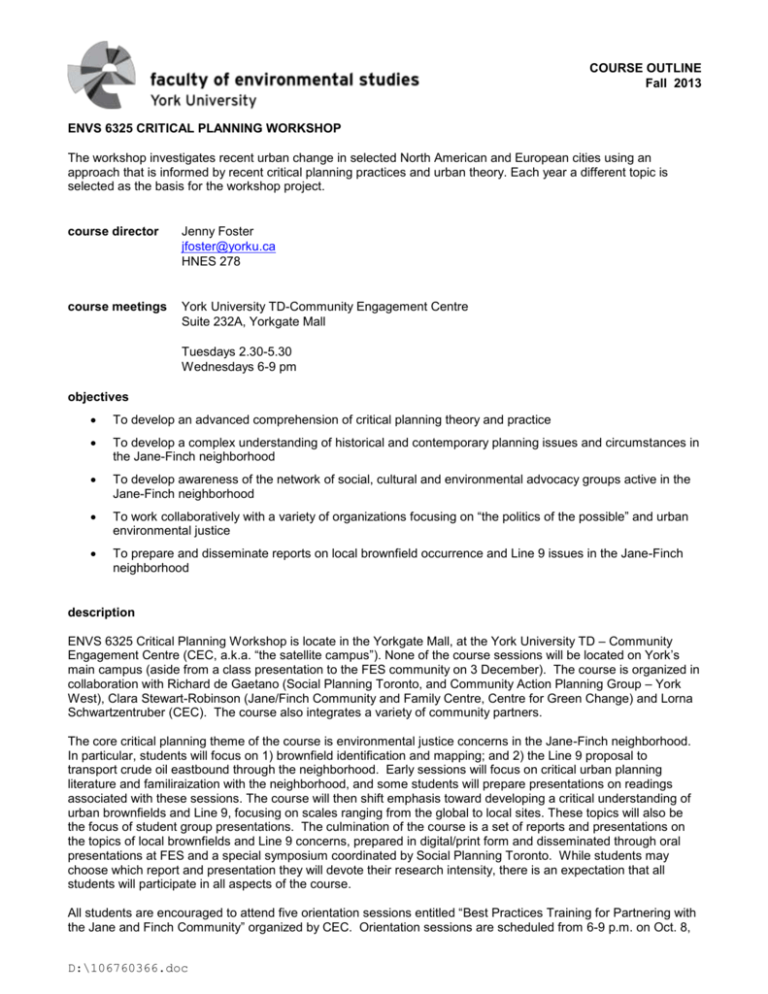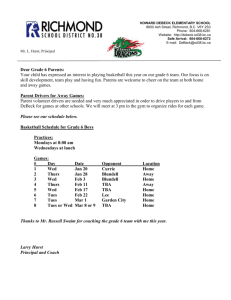critical planning workshop course outline - York U
advertisement

COURSE OUTLINE Fall 2013 ENVS 6325 CRITICAL PLANNING WORKSHOP The workshop investigates recent urban change in selected North American and European cities using an approach that is informed by recent critical planning practices and urban theory. Each year a different topic is selected as the basis for the workshop project. course director Jenny Foster jfoster@yorku.ca HNES 278 course meetings York University TD-Community Engagement Centre Suite 232A, Yorkgate Mall Tuesdays 2.30-5.30 Wednesdays 6-9 pm objectives To develop an advanced comprehension of critical planning theory and practice To develop a complex understanding of historical and contemporary planning issues and circumstances in the Jane-Finch neighborhood To develop awareness of the network of social, cultural and environmental advocacy groups active in the Jane-Finch neighborhood To work collaboratively with a variety of organizations focusing on “the politics of the possible” and urban environmental justice To prepare and disseminate reports on local brownfield occurrence and Line 9 issues in the Jane-Finch neighborhood description ENVS 6325 Critical Planning Workshop is locate in the Yorkgate Mall, at the York University TD – Community Engagement Centre (CEC, a.k.a. “the satellite campus”). None of the course sessions will be located on York’s main campus (aside from a class presentation to the FES community on 3 December). The course is organized in collaboration with Richard de Gaetano (Social Planning Toronto, and Community Action Planning Group – York West), Clara Stewart-Robinson (Jane/Finch Community and Family Centre, Centre for Green Change) and Lorna Schwartzentruber (CEC). The course also integrates a variety of community partners. The core critical planning theme of the course is environmental justice concerns in the Jane-Finch neighborhood. In particular, students will focus on 1) brownfield identification and mapping; and 2) the Line 9 proposal to transport crude oil eastbound through the neighborhood. Early sessions will focus on critical urban planning literature and familiraization with the neighborhood, and some students will prepare presentations on readings associated with these sessions. The course will then shift emphasis toward developing a critical understanding of urban brownfields and Line 9, focusing on scales ranging from the global to local sites. These topics will also be the focus of student group presentations. The culmination of the course is a set of reports and presentations on the topics of local brownfields and Line 9 concerns, prepared in digital/print form and disseminated through oral presentations at FES and a special symposium coordinated by Social Planning Toronto. While students may choose which report and presentation they will devote their research intensity, there is an expectation that all students will participate in all aspects of the course. All students are encouraged to attend five orientation sessions entitled “Best Practices Training for Partnering with the Jane and Finch Community” organized by CEC. Orientation sessions are scheduled from 6-9 p.m. on Oct. 8, D:\106760366.doc ENVS 6325 (2) 22, Nov. 5, 19 and Dec. 3 at the CEC and at a number of TTC accessible community sites in the area. evaluation Students will be evaluated according to the following: participation: group presentation: report: report presentations: 20% 20% 30% 30% Students are expected to attend all course sessions and actively engage with course materials, themes and projects. If there is a compelling reason for absence, please inform the Course Director in writing, preferably prior to absence. 20% of the course grade is based on a group presentation, where students lead the seminar. Groups of 2 or 3 students will collectively review the readings (assume that students enrolled in the course have read them) and pose questions that stimulate a complex class discussion. Presentations should cover at least the following: - identify main themes of the readings - provide a critical overview of the strengths and weaknesses of the readings - identify key extracts and quotations from the readings - relate themes to previous material and experiences - prepare at least four questions for group response The major research for this course is a group project. Students can choose to focus their participation on either creating a brownfield map of the Jane-Finch neighborhood or preparation of a community information report on local implications of Enbridge’s proposed Line 9 Reversal Project. Students will determine the content and format of their projects. Presentations will occur at a special symposium coordinated by Social Planning Toronto on 27 November and an open session in FES on 2 December. course timeline 10 Sep (Tues): intro, with Lorna Schwartzentruber 11 Sep (Wed): meet Richard De Gaetano and Clara Stewart-Robinson 16 Sep (Mon): daytime neighborhood walking tour, with Wanda McNevin (Jane/Finch Community and Family Centre 18 Sep (Wed): evening neighborhood walking tour, with Antonius Clarke (Friends in Trouble) 24 Sep (Tues): Critical urban planning readings, part 1 Marcuse, Peter (2010) “Changing Times, Changing Planning: Critical Planning Today” Progressive Planning 182, pp. 13-16 James, Carl E. (2012) Life at the Intersection: Community, Class and Schooling (Toronto: Fernwood Books) chapter 1: “Community, Stigmatization and Opportunities” and chapter 2: “Jane-Finch: A Profile” (pp.-) Marcelo Lopes de Souza (2006) “Social movements as ‘critical urban planning’ agents” City: analysis of urban trends, culture, theory, policy, action 10(3): 327-342 Sager, Tore (2013) Reviving Critical Planning Theory (London: Routledge). Chapter 3: “Activist modes of planning: A systematic overview”, pp. 66-95. 25 Sep (Wed): determining study scale, types of data guest speaker: Winston LaRose, Jane Finch Concerned Citizens Organization Peter Marcuse (2005) “Study areas, sites. And the geographic approach to public action”, in Carol J. Burns and Andrea Kahn (eds.) Site Matters: Design Concepts, Histories, and Strategies (London: Routledge) pp. 249-279. ENVS 6325 (3) Walker, Gordon (2012) Environmental Justice: Concepts, Evidence and Politics (London: Routledge). Chapter 9: “Analysing environmental justice”, pp. 214-221. Graeme Stewart (2007) “Toronto’s modern suburbs and the concrete high-rise”, in Michael McClelland and Graeme Stewart (eds.) Concrete Toronto: A Guidebook to Concrete Architecture From the Fifties to the Seventies, pp. 212-217. 1 Oct (Tues): Critical urban planning readings, part 2 Katherine N. Ranking (2009) “Critical development studies and the praxis of planning” City: analysis of urban trends, culture, theory, policy, action 13(2-3): 219-229. Wendy Sarkissian and Dianna Hurford (2010) Creative Community Planning: Transformative Engagement Methods for Working at the Edge (London: Earthscan), chapter 8: “Learning at the margins: Margo Fryer and Pamela Ponic on deconstructing power and privilege”, pp. 105-116. Delores Hayden (1997) The Power of Place: Urban Landscapes as Public History (Cambridge: The MIT Press), chapter 2: “Urban landscape history: The sense of place and the politics of space”, pp. 14-43. 2 Oct (Wed): Humber Report Card and SNAP program, Cathrin Winklemann (TRCA) Toronto and Region Conservation Authority (2012) Black Creek SNAP: Growing Food and Growing Opportunities. Available at: http://sustainableneighbourhoods.ca/dotAsset/140099.pdf 8 Oct (Tues): community education and justice planning models Indigenous Environmental Network: http://www.ienearth.org/ Highlander Research and Education Centre: http://highlandercenter.org/ Sustainable South Bronx: http://www.ssbx.org/ Southwest Workers Union: http://www.swunion.org/ Together North Jersey: http://togethernorthjersey.com/ Capacity Global: http://www.capacity.org.uk/ Center on Race, Poverty and the Environment: http://www.crpe-ej.org/crpe/ Environmental Health Coalition: http://www.environmentalhealth.org/index.php/en/ 9 Oct (Wed): City of Toronto: Chemtrack program 16 Oct (Wed): field research (baseline data) 22 Oct (Tues): Brownfield readings M. Hayek, M. Novak, G. Arku and J. Gilliland (2010) “Mapping Industrial Legacies: Building a Comprehensive Brownfield Database in Geographic Information Systems” Planning Practice & Research 25(4): 461-475. Justin B. Hollander, Niall G. Kirkwood and Julia L. Gold (2010) Principles of Brownfield Regeneration (Washington: Island Press). Chapter 2: “Approaching brownfield redevelopment, pp. 7-19, and chapter 3: “Remediation”, pp. 21-50. Justin Steil and James Connolly (2009) “Can the Just City be built from Below? Brownfields, planning and power in the South Bronx”, In Peter Marcuse; James Connolly; Johannes Novy; Ingrid Olivo; Cuz Potter; Justin Steil (eds) Searching for the Just City: Debates in Urban Theory and Practice (London: Routledge) Pp. 173-193. Laura Solitare and Karen Lowrie (2012) “Increasing the capacity of community development corporations for brownfield redevelopment: an inside-out approach” Local Environment 17(4): 461–479. 23 Oct (Wed): Line 9 readings Enbridge, Line 9 Reversal Phase 1 Project Overview, Available at: wttp://www.enbridge.com/ECRAI/Line9ReversalProject Environmental Defence, Enbridge’s Tar Sands Pipeline Plan: All Pain and No Gain for Ontario, Available at: http://environmentaldefence.ca/enbridgestarsandspipelineplan ENVS 6325 (4) Jeff Lewis (2013) “Ontario municipalities raise oil spill concerns on Enbridge pipeline reversal” Financial Post 13 March 2013, Available at: http://business.financialpost.com/2013/03/25/ontario-municipalitiesraise-oil-spill-concerns-on-enbridge-pipeline-reversal/?__lsa=6fed-e1de 29 Oct (Tues): Black Creek Community Health Centre discussion, with JoesiAnn Nelson 5 Nov (Tues): Line 9, with Sonia Grant (Rising Tide Toronto) 6 Nov (Wed): CELA/TEA discussion (Kathleen Cooper and Heather Marshall) PollutionWatch and CELA (2008) “An Examination of Pollution and Poverty in the Great Lakes Basin”, available at http://s.cela.ca/files/633_PW_SE_Study.pdf 12 Nov (Tues): mapping readings Nancey Green Leigh & Sarah L. Coffin (2000) “How Many Brownfields Are There? Building an Industrial Legacy Database” Journal of Urban Technology 7(13): 1-18. Andil Gosine and Cheryl Teelucksingh (2008) Environmental Justice and Racism in Canada: An Introduction (Toronto: Emond Montgomery Publications Limited), chapter 3: “Geographic information systems in environmental justice: Tools for social change”, pp. 63-88. Edward W. Soja (2003) “Tales of a geographer-planner”, in Barbara Eckstein and James A Thogmorton (eds.) Story of Sustainablity: Planning, Practice and Possibility for American Cities Cambridge: The MIT Press), pp. 207-224 Nadia Amoroso (2010) The Exposed City: Mapping the Urban Invisibilities (London: Routledge), chapter 4: “The map-art: The works of James Corner”. Pp. 93-114 13 Nov (Wed): examples of brownfield mapping, brainstorming project parameters 19 Nov (Tues): field research 20 Nov (Wed): field research 26 Nov (Tues): field research 27 Nov (Wed): Social Planning Toronto symposium 3 Dec (Tues): FES presentation 4 Dec (Wed): debrief and partner potuck academic honesty All York students are subject to policies regarding academic honesty as set out by the Senate of York University and by the Faculty of Environmental Studies (FES). Students are strongly encouraged to read the Senate Policy on Academic Honesty, a copy of which can be found on the York University web-site (http://www.yorku.ca/secretariat/legislation/senate/acadhone.htm). FES is committed to maintaining the highest standards of academic integrity. Please be advised that conduct that violates the ethical or legal standards of the University community may result in serious consequences. For more information, please contact the Director, Student and Academic Services and/or the FES Writing Program Coordinator. research ethics Students who conduct a research study using human participants must submit the following for approval prior to the conduct of research: 1. three copies of a proposal outlining the purpose of the research and the methodology to be used 2. three copies of the Faculty of Environmental Studies Human Participants Research Protocol Form, and 3. three copies of the Written Informed Consent form or a script of Verbal Informed Consent (Verbal Informed consent is permissible only in extenuating circumstances, where written communication is not feasible). This material will be reviewed by a Sub-committee of the Research and Awards Committee. Reviews will take up to 2 weeks from the date of submission. If the research is not approved prior to the conduct of the research, then ENVS 6325 (5) the research will not have received research ethics clearance and will be deemed unacceptable for submission as a component of this course. Information regarding the use of human participants in research studies may be found on the Faculty of Graduate Studies webpage http://www.yorku.ca/grads/polc/ethics.htm. Students are advised that all human participants in the research must have either signed a written consent form or have provided oral consent for their participation in the research. Students also are advised that the consent forms must be retained by the Principal Investigator for two years following the completion of the research. PLEASE NOTE: Students who feel that there are extenuating circumstances that may interfere with the successful completion of the course requirements are encouraged to discuss the matter with the course director as soon as possible. Students with physical, learning or other disabilities who require reasonable accommodations in teaching style or evaluation methods should discuss this with the course director early in the term so that appropriate arrangements can be made. Copies of this and other FES Course Outlines may be obtained in Room 137 Health, Nursing, and Environmental Studies Bldg.





